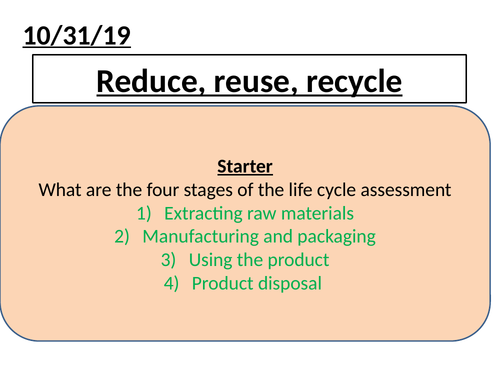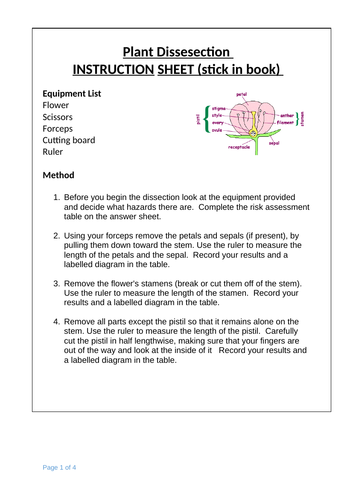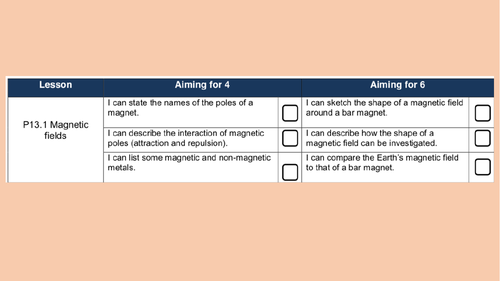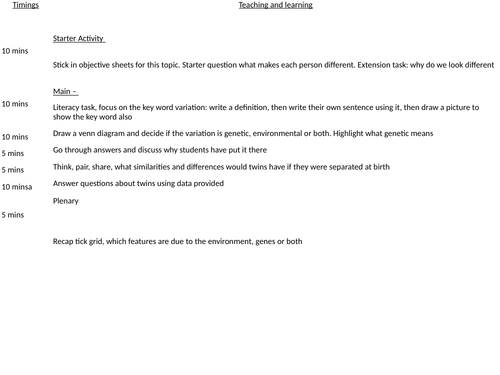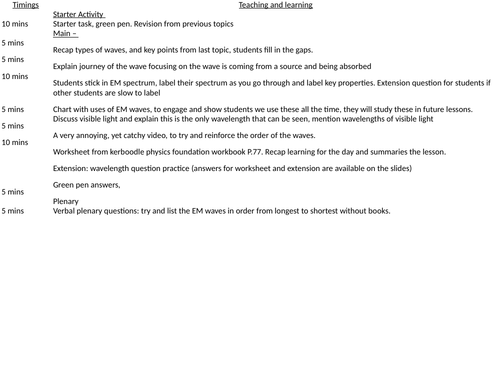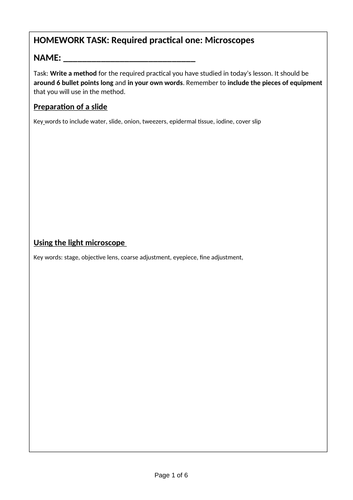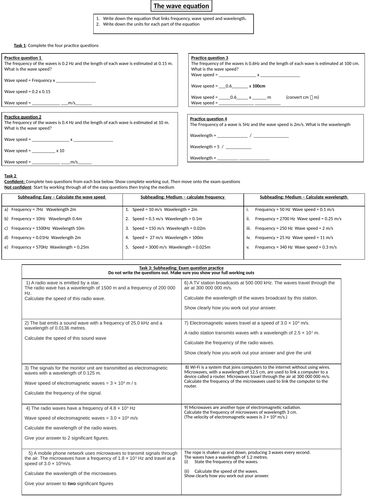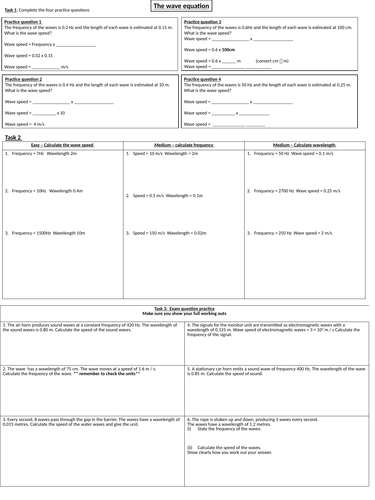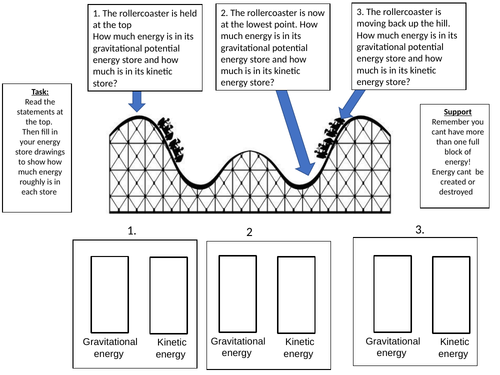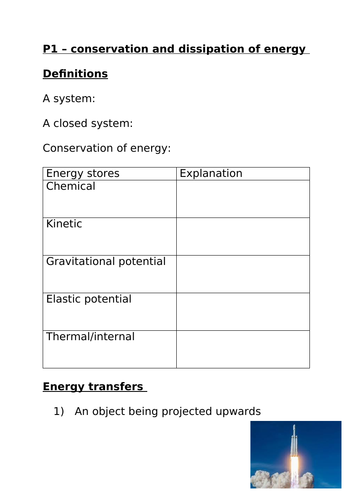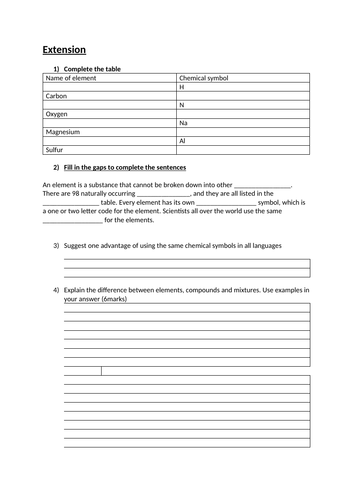
124Uploads
36k+Views
9k+Downloads
All resources

C12.6 reduce reuse recycle
Aimed at low ability students, targets of level 4s
Starter: recap on stages of LCA
Main: link up key words to defintions for three R’s
Pictures on board of different items, what are they made of ? can they be recycled?
Discuss three R’s with students
using textbooks students then make an information sheet using the success criteria on the powerpoint
Plenary: 6 mark question about the the three r’s

B16.1 feeding relationships
Aimed at low ability KS4 students, targets of level 3/4
Starter: Differentiated synoptic questions linking to B8 photosynthesis.
Main: match up key words, then link key words to food chain.
differentiated 6 mark question.
Broken down 6 mark question to build confidence, focusing on key words. Bronze/silver supportive sheets Gold students just answer the question.
Plenary: Mark scheme on powerpoint for students to mark and improve their answer.

Microscopes required practical
Aimed at a mixed ability year 9 class
Starter: Differentiated exam questions answers on the powerpoint to mark
Main: Required practical, worksheet to complete alongside. Answers on the powerpoint to self assess after
Extension: magnification exam questions to practice , answers on the powerpoint
Plenary: Pack up, write equation from memory
Homework sheet: Exam questions on magnification and method to write for the practical

Structure of a plant
Aimed at KS3 students.
This lesson recaps KS2 prior knowledge on the structure of a plant. Before moving onto KS3 content about structure and function of parts of the plant, followed by a plant dissection, accompanied by worksheets.

P13.1 Magnetic Fields
P13.1 accordin to AQA Kerboodle
Aimed at a low ability foundation class (targets level 4)
Stater: pictures to guess the title
Main: practical element to find out what poles of magnets do. Then to use iron fillins/compasses to show field lines. can be demoed
Work sheet to consolidate knowledge with an extension on induced/permanent magnets
Plenary: true/false questions based on content from the lesson

B13.1 variation and evolution
Aimed at a low ability class.
Starter Activity
Stick in objective sheets for this topic. Starter question what makes each person different. Extension task: why do we look different
Main –
Literacy task, focus on the key word variation: write a definition, then write their own sentence using it, then draw a picture to show the key word also
Draw a venn diagram and decide if the variation is genetic, environmental or both. Highlight what genetic means
Go through answers and discuss why students have put it there
Think, pair, share, what similarities and differences would twins have if they were separated at birth
Answer questions about twins using data provided
Plenary
Recap tick grid, which features are due to the environment, genes or both

C11.3 greenhouse gases
Aimed at foundation students, targets of level 4
Starter: differentiated bronze/silver/gold starter questions with answers
Main:
Draw the greenhouse effect using info from powerpoint. extension question to challenge students
Fact hunt: questions to answer using textbook
Video on deforestation, questions to answer from video
Plenary: animated true/false statements

C11.5 atmospheric pollutants
aimed at foundation level 4 targets
Differentiated bronze/silver/gold starter
Main: recap complete and incomplete combustion, put piece of pot over blue/yellow flame on bunsen burner
Students fill in worksheet, to say what they saw and the difference between incomplete and complete combustion
Students fill in information grid using textbooks, to find the causes of the atmospheric pollutants and the problems with them
Answers for students to check their answers with

P12.1 Electromagnetic spectrum
Aimed at low ability students. Targets of level 4.
Starter task, green pen. Revision from previous topics
Main –
Recap types of waves, and key points from last topic, students fill in the gaps.
Explain journey of the wave focusing on the wave is coming from a source and being absorbed
Students stick in EM spectrum, label their spectrum as you go through and label key properties. Extension question for students if other students are slow to label
Chart with uses of EM waves, to engage and show students we use these all the time, they will study these in future lessons. Discuss visible light and explain this is the only wavelength that can be seen, mention wavelengths of visible light
A very annoying, yet catchy video, to try and reinforce the order of the waves.
Worksheet from kerboodle physics foundation workbook P.77. Recap learning for the day and summaries the lesson.
Extension: wavelength question practice (answers for worksheet and extension are available on the slides)
Green pen answers,
Plenary
Verbal plenary questions: try and list the EM waves in order from longest to shortest without books.

Biology paper 1 revision
complete paper one revision.
Aimed at low ability foundation students.
Inspired by Dr Edmunds
Booklets include fact sheets for each topic, each fact sheet has page numbers from the CGP foundation revision guide for support.
There are answers for these fact sheets for students to check their answers.
Each topic also has a page of exam questions for students to practice their knowledge. answers for these are in the back of the booklets
Hopefully will be of help.
Any feedback welcome :)

Microscopes required practical
Three differentiated resources. Cant be used as homewowrk or for required practical revision. Good to use as a retreival resource after the practical.
Each differentiated resource has a space to write the required practical method, low level sheets have key words to guide them. Each resource has different exam questions dependent on level.
All answers included.
I print 2 sheets per side, back to back. Be careful if you shrink to A5 some of the answers for the magnfication questions will change as the image size measured will be different.

Eukaryotic and Prokaryotic cells
Combining both B1.2 and B1.3 from the kerboodle topic
Starter: No goal starter, images of plant and animal cell and a microscope. students can add any information they already know. Images can be printed or a list of what they know can be wrote. To be referred to at the end of the topic, assess prior knowledge
Main:
Label plant and animal cell, differentiated version available, animated answers embedded in the powerpoint
Match structure and function of organelles
Show students bacterial cell, students draw and label their own, before filling in the comparison tick box to compare animal, plant and bacteria cells. Stretch task available
Explain key words prokaryotic and eukaryotic, then students complete the assessed questions showing understanding of differences between these cells. Self assess answer using mark scheme
Plenary
Plenary grid, can be done individually or as teams. Covers key concepts from the lesson, answers on the following slide

wave equations
Aimed at higher ability students
Starter: retrieval questions based on P1
Main: Mini review of parts of the wave.
Both wave period and wave speed equations shown with examples in the powerpoint.
Differentiated worksheet to consolidate wave equation, starting with faded practice, followed by lots of SLOP, and finally exam questions on the wave equation.
All answers are on the powerpoint
Plenary: Mini white board plenary

wave equation
Aimed at foundation students
Starter: Retrieval practice questions based on P1
Main: Mini recap of parts of a wave and key definitions.
Both period and wave speed equation demonstrated on powerpoint with examples and practice.
Then move onto the SLOP worksheet with faded practice and exam questions. All answers on the power point
Plenary: Mini white board plenary

Energy transfer diagrams
Using energy transfer diagrams to help with the understanding that energy is conserved.

P1 conservation and dissipation of energy summary
Summary powerpoint covering the P1 conservation and dissipation of energy topic from the AQA specification. (Kerboodle P1)
Contains a work booklet for students to use and make notes/do tasks/answer questions in whilst teacher runs through powerpoint.
Good for a summary/revision lesson.
All answers are on the powerpoint.

Physics paper 1 revision
Complete paper one Physics revision following the AQA trilogy specification.
Parts for higher only are highlighted.
work booklets to accompany powerpoint, which can be used in lessons or revision sessions.
Questions embedded in the powerpoint with answers for students to practice and focus on key concepts
My year 11s have found these benefical.

Elements and compounds KS3
Elements, compounds and mixtures- Some resources are from other areas on TES
Targeted at year 8 mixed ability class.
Starter: 5 minutes timed activity, challenege to see how many words students can make from the periodic table
Main: Go over definitons of elements/compounds/mixtures.
Then use these definitons to identify which particle pictures are elements/compounds
Go over rules of particle diagrams, then a choice of higher or lower ability sheet.
Higher ability sheet: students need to draw particle diagrams
lower ability sheet: students need to identify the correct particle picture
Extension: Worksheet, including tasks such as identifying elements, a fill in the gaps activity, 6 mark practicce question to explain the difference between elements/compounds/mictures
Plenary: Break the code using the periodic tab;e

